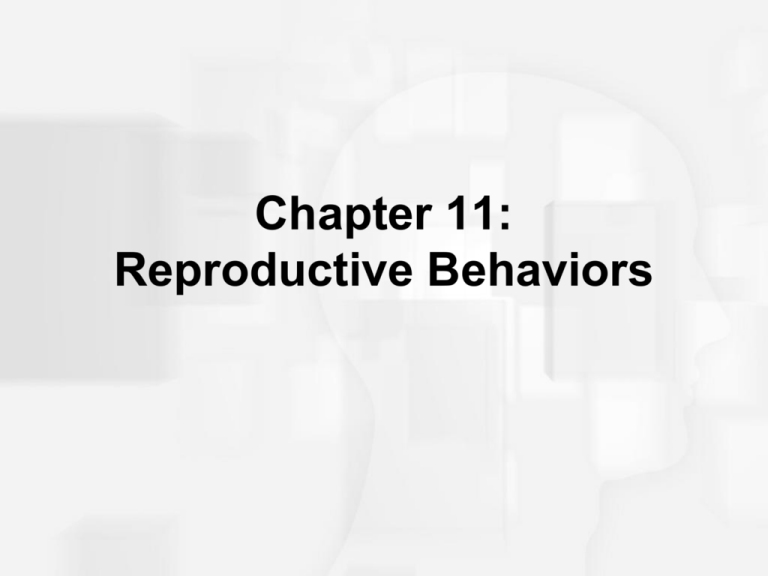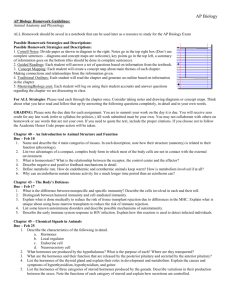
Chapter 11:
Reproductive Behaviors
Sex and Hormones
•
The sex hormones are a special kind of
steroids, released mostly by the gonads and
to a lesser degree by the adrenal glands.
– affect the brain, genital and other organs
• Two types of sex hormones include:
1. Androgens
2. Estrogens
• Both sexes have these categories in varying
quantities .
Sex and Hormones
• Androgens are a groups of sex hormones
that include testosterone and others.
• Generally referred to as “male hormones”
because men have higher levels than
women.
Sex and Hormones
• Estrogens include estradiol and others and
are referred to as “female hormones”
because women have higher levels.
• Progesterone is a type of hormone that
prepares the uterus for the implantation of a
fertilized ovum and promotes the
maintenance of pregnancy.
Sex and Hormones
• “Sex limited genes” are those activated by
androgens or estrogens and control most of
the differences between male and female.
– Example: estrogens activate the gene for
breast growth; androgens activate the
gene for the growth of facial hair in men.
• Sex hormones increase or decrease the rate
of apoptosis in various regions of the brain.
– Certain areas are slightly larger in males or
females
Sex and Hormones
•
Sex hormones can have the following
effects:
1. Organizing effects- occur mostly at sensitive
stages of development.
-Determine whether the brain and body
will develop male or female
characteristics
2. Activating effects- occur at any time of life
and temporarily activate a particular
response.
Sex and Hormones
• The distinction between the activating and
organizing effects of hormone is not absolute.
– Example: hormones early in life can exert
temporary effects; during puberty
hormones can also induce long-lasting
structural changes
Sex and Hormones
• Obvious differences can exist between the
reproductive organs and the gonads of males
and female.
• Sexual differentiation begins with the
chromosomes.
• Female mammal has two X chromosomes
and a male has an X and a Y.
• During an early stage of prenatal
development, both male and female have a
set of Mullerian ducts and a set of Wolffian
ducts as well as primitive gonads.
Sex and Hormones
• Wolffian ducts are the precursors to other
male reproductive organs.
– Develop into the vas deferens and seminal
vesicles.
• Mullerian ducts are precursors to the female’s
oviducts, uterus, and upper vagina.
Sex and Hormones
• The male Y chromosome includes the SRY
gene which causes the primitive gonads to
develop into testes, the sperm-producing
organ.
• The developed testes produce the hormone
testosterone.
• Testosterone induces the development of the
penis and scrotum.
• Females are not exposed to high
testosterone levels and their gonads develop
into ovaries, the egg-producing organs.
Sex and Hormones
• Sensitive periods are early periods when
hormones have long-lasting effects.
• Sexual differentiation depends mostly on the
level of testosterone during a sensitive
period.
• The human sensitive period for genital
formation is about the third and fourth month
of pregnancy.
Sex and Hormones
• Female rats exposed to testosterone shortly
before or after birth are partly masculinized in
anatomy and behavior.
– Clitoris grows larger than normal
– At maturity, pituitary and ovaries produce
steady levels of hormones instead of
cycles
– Parts of the hypothalamus appear more
male
– Sexual behavior becomes masculinized
Sex and Hormones
• Extra estradiol does not determine whether
the individual looks female or male.
• Estradiol and other estrogens do modify
various aspects of the development of the
brain and the internal sexual organs.
• The absence of sex hormones generally
leads to female-looking external genitalia
• If a male rat lacks androgen receptors or is
castrated, it develops female-like anatomy
and behavior.
Sex and Hormones
• Sex hormones early in life bind to receptors in
specific areas of the hypothalamus,
amygdala, and other brain areas and produce
anatomical and physiological differences.
• The sexually dimorphic nucleus is an area in
the anterior hypothalamus that is larger in the
male and contributes to control of male
sexual behavior.
• Parts of the female hypothalamus generate a
cyclical pattern of hormone release; the
hypothalamus of a male cannot.
Sex and Hormones
• During early development in rodents,
testosterone is converted within certain brain
cells to estradiol, which masculinizes
development.
• Alpha-fetoprotein is found in the blood during
early sensitive periods and binds to estrogen
and prevents it from entering developing
cells.
• Testosterone does not bind to alphafetoprotein and freely enters the cell.
Sex and Hormones
• In adulthood, sex hormones exert activating
effects to temporarily modify behavior.
• Behavior can also influence hormone
secretion.
• Hormones do not cause behavior but rather
alter the activity in various brain areas to
change the way the brain responds to certain
stimuli.
• Hormones also change sensitivity in the
penis, vagina and cervix.
Sex and Hormones
• Sex hormones facilitate sexual behavior.
• Arousal also depends on previous sexual
experience.
• Sex hormones activate sexual behavior by
enhancing sensations.
• Estrogens increase the sensitivity of the
pudendal nerve, which transmits tactile
stimulation from the pubic area to the brain.
Sex and Hormones
• Sex hormones also increase responses of
certain areas of the hypothalamus.
– the ventromedial nucleus, the medial
preoptic area (MPOA), and the anterior
hypothalamus.
• Stimulation of an area known as the sexually
dimorphic nucleus (SDN) found in the anterior
hypothalamus is larger in males and
increases sexual behavior in males of many
species.
Sex and Hormones
• Testosterone and estradiol trigger the release
of dopamine by the MPOA and other areas.
• Dopamine stimulation of D1 and D5 receptors
is associated with sexual arousal.
– Facilitates erection of the penis and
sexually receptive postures in females
• Higher concentrations of dopamine stimulate
D2 receptors and lead to orgasm.
• Serotonin activity decreases sexual activity by
blocking dopamine release.
Sex and Hormones
• Humans are less dependent on current sex
hormones than other species but changes
can increase or decrease sexual arousal.
• For males, levels of testosterone correlate
positively with sexual arousal and the drive to
seek out partners.
Sex and Hormones
• Decreases in testosterone levels generally
decrease male sexual activity and interest.
– Example: castration
• Impotence is the inability to maintain an
erection.
– usually caused by impaired blood
circulation, not low testosterone.
• Erection partially depends on testosterone
increasing the release of nitric oxide.
– facilitates the hypothalamic neurons and
increases blood flow to the penis.
Sex and Hormones
• Most sex offenders have normal testosterone
levels.
• Hormone levels do not completely explain the
behaviors.
• Testosterone reduction has been tried as a
means of controlling sex offenders as it
reduces sexual activities.
• Results favorable for those who continue
taking medication, but dropout rate is high.
Sex and Hormones
• In women, the hypothalamus and pituitary
interact with the ovaries to produce the
menstrual cycle.
• The menstrual cycle is the periodic variation
in hormones and fertility over the course of
about 28 days.
Sex and Hormones
• After the end of a menstrual period:
– the anterior pituitary releases folliclestimulating hormone (FSH)
– FSH promotes the growth of a follicle in the
ovary.
– The follicle nurtures the ovum and
produces estrogen.
• Towards the middle of the menstrual cycle,
the follicle builds up receptors to FSH.
• As a result, the follicle produces increasing
amounts of estradiol, a type of estrogen.
Sex and Hormones
• Increased estradiol causes the anterior
pituitary to increase release of FSH and
luetinizing hormone (LH).
• FSH an LH cause the follicle to release an
ovum.
• The remnants of the follicle release the
hormone progesterone.
– prepares the uterus for implantation of a
fertilized ovum
– inhibits the further release of LH
Sex and Hormones
• If the ovum is not fertilized, the lining of the
uterus is cast off and menstruation occurs.
• If the ovum is fertilized, the levels of estradiol
and progesterone increase gradually
throughout pregnancy.
Sex and Hormones
• Birth control pills prevent pregnancy by
interfering with the usual feedback cycle
between the ovaries and pituitary.
• The “combination-pill” contains both estrogen
and progesterone and prevents the surge of
FSH and LH that would release an ovum.
– also thickens the mucus of the cervix
making it harder for the sperm to reach the
egg.
Sex and Hormones
• The periovulatory period is the time of
maximum fertility and high estrogen levels
when ovulation occurs.
• Studies suggest that women become more
sexually responsive during this time when
estrogen levels are high.
– Show increased attention to sex-related
stimuli.
– show increased mate preference towards
men who act and look more masculine.
Sex and Hormones
• Oxytocin is a pituitary hormone also important
for reproductive behavior.
• Stimulates contraction of the uterus during
delivery of a baby
• Stimulates the mammary gland to release
milk.
• Released during orgasm and triggers a state
of complete relaxation.
• Facilitates formation of pair bonds between
mating partners and mother and infant
Sex and Hormones
• Hormones released around the time of giving
birth facilitate maternal behavior in females.
• Late in pregnancy, the female secretes large
amounts of estradiol, prolactin, and oxytocin.
• Prolactin is necessary for milk production.
• Oxytocin is associated with maternal behavior
and social attachment.
Sex and Hormones
• Females also change patterns of hormone
receptors.
• Late in pregnancy, the brain increases its
sensitivity to estradiol in areas responsible for
maternal behavior, but not for sexual
behavior.
• The hormonal changes increase the attention
of the mother to the young after birth.
• Hormones also increase activity in the medial
preoptic area and the anterior hypothalamus.
Sex and Hormones
• Vasopressin is a hormone synthesized by the
hypothalamus and secreted by the posterior
pituitary gland.
– associated with establishing long-term
bonds in some species.
• Mothers are also stimulated by the odors of
their babies.
– Infant rats release chemicals that stimulate
the mother’s vomeronasal organ.
Variations in Sexual Behavior
• A wide degree of variation exists between
people in terms of frequency of sexual
behavior, preferred types of sexual activity,
and sexual orientation.
• Evolutionary explanations are controversial in
explaining mating behavior.










